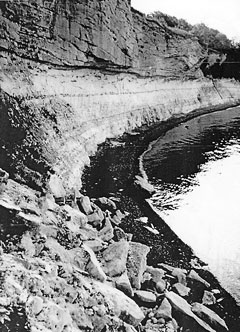
 |
de Steensplinter — Geology and a cosmology of the obvious | 6.1 interference |

• the Stevns Klint section, Denmark: an abrupt stop of chalky limestone deposition marks the impact of a meteriorite in Yucatan (photograph Jan Smit). notes 20 I use here the term `locality' in its every day sense. 21 Old (550? BC - 500 AD) Indian logicians used the example: "the river is swollen, it has been raining in the mountains". 22 I discussed this lack of evidence of gradual evolution in 1968 and was duly cited in the papers published four years later by Eldredge and Gould, who had come to the same conclusions independently. They invented the useful term `punctuated equilibria'. I mention all this because of a debt. As a matter of fact we all three re-invented the wheel. The first discoverer of this phenomenon was the Englishman William Smith, who published the succession of guide fossils in the British Jurassic layers as early as 1817. For cases of step-wise evolution see Mac Gillavry 1968 and 1978 (bibliography). previous (website version 2.30 - august 2007) |
interference 1. continuity 2. discontinuity continuity Most of the time we are inclined to assume that an inorganic process that is going to take place in the next moment - i.e. in the next present - will follow `causally' out of what went on before at the same locality 20 or its surroundings 21 (continuity). At the same time we know that this is by no means always so. Are not the newspapers full of unexpected discontinuities: tsunamis, earthquakes, etc.? In the cosmology of successive processes, there is no primary reason to assume that new processes should be fully determined by the past. What happens in the next present could be a realization out of a field of possible (admissible) materializations. There could be an element of pure chance. And there can be entirely new processes. On our planet we are fortunate to have many places where records of processes are found in direct superposition on the records of preceding processes. We can compare them and check whether there is any relation between the overlying layer and what lies below. I will try to illustrate the difference between continuity and dis continuity. If what I write becomes too technical, you can skip a few paragraphs. local continuity In some of our bore-holes in Sumatra we encountered a thick section of Miocene (mid-Tertiary) monotonous fine-grained deep-sea sediment. These intervals could be more than 800 meters thick, representing many million years of sedimentation. The monotony suggests that the conditions of sedimentation remained the same in all that time. These sediments are laid down on the sea-floor which - as it is the boundary between sediment and water - would go up and up, were it not that the underground of the zone of these wells was sinking during this time between two enormous faults. Such a structure is technically called a `graben'. These sediments contain the empty calcareous tests of one-cellular pelagic (free swimming) Foraminifera, rained down from the water near the sea-surface. Most biologists think that we do not see evidence of evolution going on, because of the slowness of the process of gradual evolution. If that were true, we would expect to see some evidence of evolution in these fossil communities in such an extent of time. What I found was that the lower part of these sections contained the remains of a fauna in equilibrium that did not show any sign of evolution, thus confirming that the conditions indeed remained the same. Higher up at a certain level some species disappeared and one or two others came in and a new equilibrium of living community was formed. 22 continued |
| © 2007 - uitgeverij de Steensplinter - All rights reserved |